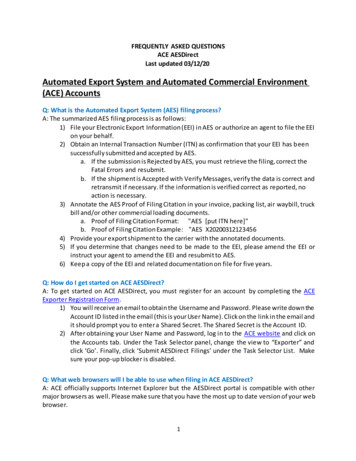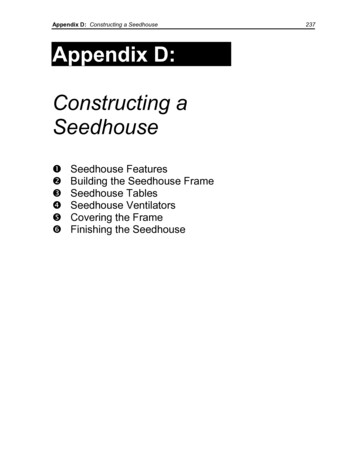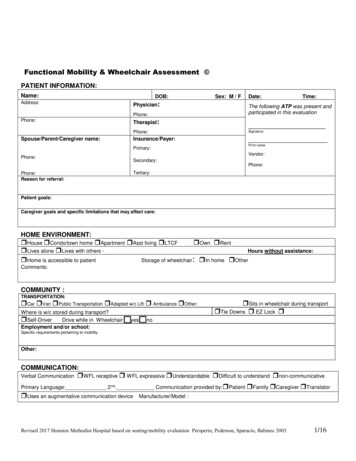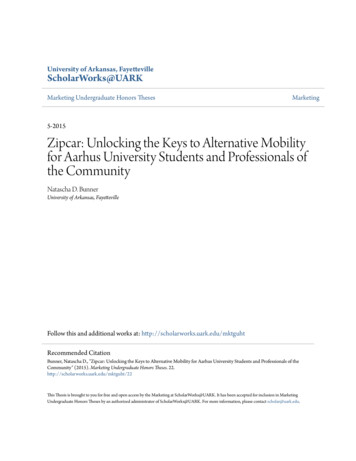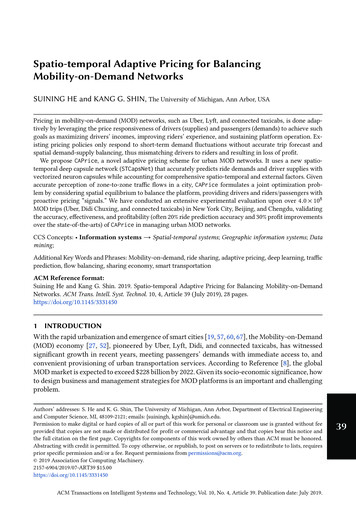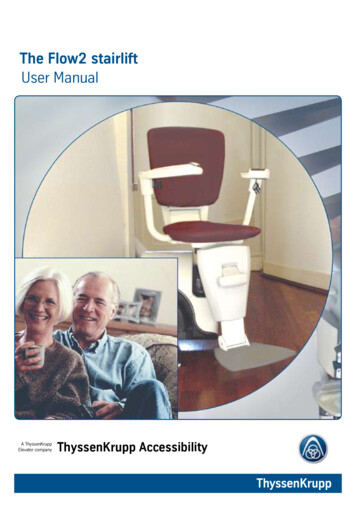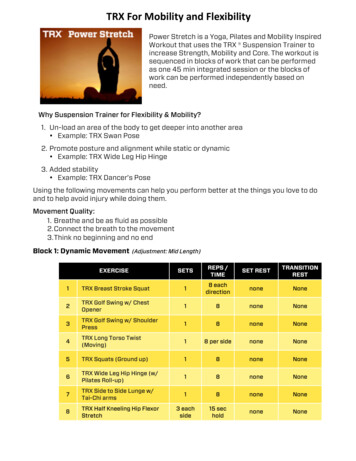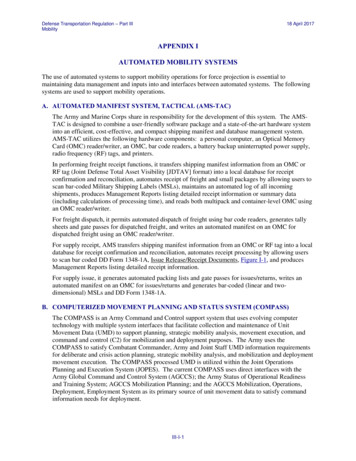
Transcription
Defense Transportation Regulation – Part IIIMobility18 April 2017APPENDIX IAUTOMATED MOBILITY SYSTEMSThe use of automated systems to support mobility operations for force projection is essential tomaintaining data management and inputs into and interfaces between automated systems. The followingsystems are used to support mobility operations.A. AUTOMATED MANIFEST SYSTEM, TACTICAL (AMS-TAC)The Army and Marine Corps share in responsibility for the development of this system. The AMSTAC is designed to combine a user-friendly software package and a state-of-the-art hardware systeminto an efficient, cost-effective, and compact shipping manifest and database management system.AMS-TAC utilizes the following hardware components: a personal computer, an Optical MemoryCard (OMC) reader/writer, an OMC, bar code readers, a battery backup uninterrupted power supply,radio frequency (RF) tags, and printers.In performing freight receipt functions, it transfers shipping manifest information from an OMC orRF tag (Joint Defense Total Asset Visibility [JDTAV] format) into a local database for receiptconfirmation and reconciliation, automates receipt of freight and small packages by allowing users toscan bar-coded Military Shipping Labels (MSLs), maintains an automated log of all incomingshipments, produces Management Reports listing detailed receipt information or summary data(including calculations of processing time), and reads both multipack and container-level OMC usingan OMC reader/writer.For freight dispatch, it permits automated dispatch of freight using bar code readers, generates tallysheets and gate passes for dispatched freight, and writes an automated manifest on an OMC fordispatched freight using an OMC reader/writer.For supply receipt, AMS transfers shipping manifest information from an OMC or RF tag into a localdatabase for receipt confirmation and reconciliation, automates receipt processing by allowing usersto scan bar coded DD Form 1348-1A, Issue Release/Receipt Documents, Figure I-1, and producesManagement Reports listing detailed receipt information.For supply issue, it generates automated packing lists and gate passes for issues/returns, writes anautomated manifest on an OMC for issues/returns and generates bar-coded (linear and twodimensional) MSLs and DD Form 1348-1A.B. COMPUTERIZED MOVEMENT PLANNING AND STATUS SYSTEM (COMPASS)The COMPASS is an Army Command and Control support system that uses evolving computertechnology with multiple system interfaces that facilitate collection and maintenance of UnitMovement Data (UMD) to support planning, strategic mobility analysis, movement execution, andcommand and control (C2) for mobilization and deployment purposes. The Army uses theCOMPASS to satisfy Combatant Commander, Army and Joint Staff UMD information requirementsfor deliberate and crisis action planning, strategic mobility analysis, and mobilization and deploymentmovement execution. The COMPASS processed UMD is utilized within the Joint OperationsPlanning and Execution System (JOPES). The current COMPASS uses direct interfaces with theArmy Global Command and Control System (AGCCS); the Army Status of Operational Readinessand Training System; AGCCS Mobilization Planning; and the AGCCS Mobilization, Operations,Deployment, Employment System as its primary source of unit movement data to satisfy commandinformation needs for deployment.III-I-1
Defense Transportation Regulation – Part IIIMobility18 April 2017C. CARGO MOVEMENT OPERATIONS SYSTEM (CMOS)CMOS is a combat support system that streamlines contingency and sustainment cargo and passengermovement processes. CMOS imports shipment requirements for Military Standard Requisitioningand Issue Procedures (MILSTRIP), non-MILSTRIP, personnel and deployment planning systems. Itsupports shipment planning through interfaces with Global Decision Support System (GDSS), GlobalFreight Management (GFM), Integrated Booking System (IBS), and commercial carrier systems andload planning through an interface with the Integrated Computerized Deployment System (ICODES).CMOS produces labels, Radio Frequency Identification (RFID) tags, and hazardous material andcommercial/military movement documentation, providing in-transit visibility (ITV) data to down linestations and Integrated Data Environment (IDE)/Global Transportation Network (GTN) Convergence(IGC).D. DELIBERATE CRISIS ACTION PLANNING AND EXECUTION SEGMENT (DCAPES)DCAPES is an application of the Global Command and Control System (GCCS) that resides on aGCCS workstation and operates in a classified, shared data environment on the SECRET InternetProtocol Router Network. Integrating Operations, Logistics, Manpower, and Personnel C2 systems,DCAPES is used by the United States Air Force (USAF) to achieve the Chairman, Joint Chiefs ofStaff goal to develop a Time-Phased Force and Deployment Data (TPFDD) within 72 hours.DCAPES links USAF planners with Joint War planners through GCCS JOPES. The purpose ofDCAPES is to enable timely, employment-driven, USAF participation in the JOPES processsupporting all levels of command, across the operational continuum using integrated tools, sharedinfrastructure, and common data consistent with the Joint and USAF Integrated C2 vision. Theobjective of DCAPES is to provide data and data manipulation capability to USAF planners andcommanders to:1. Perform rapid Operations Plan (OPLAN) development2. Conduct feasibility and capability analyses3. Support deployment, redeployment, sustainment, mobilization, and reconstitution.The DCAPES provides near real-time integrated C2, planning, and execution monitoring informationto Air Force functional users in operations, logistics, manpower, and personnel, providing a singleintegrated planning environment. With DCAPES, Air Force planners can rapidly and accuratelyidentify and source personnel, equipment, and sustainment capabilities to meet the combatantcommander’s operations plan requirements. Additionally, the DCAPES enables senior Air Forcedecision-makers to rapidly adjust operations plans to accommodate ever-changing scenarios. Theevolution of DCAPES is swiftly replacing old, stovepiped, domain-centric systems by producing asingle, fully integrated, replicated database.E. DIRECT VENDOR DELIVERY ELECTRONIC DATA INTERCHANGE (DVD EDI)Through a series of initiatives, Defense Logistics Agency (DLA) and the Military SurfaceDeployment and Distribution Command (SDDC) are working with direct vendor delivery candidatesto establish a standard set of data elements that will allow vendors to provide detailed shipping statusvia electronic data interchange. This data exchange will provide information on the content ofsustainment cargo moving outside the Defense Transportation System (DTS). Vendors will pass datato DoD automated information systems providing the initial source data required for force trackingand ITV reporting. As these DVD sustainment supplies move to the theater of operation via vendoror commercial carrier modes of transport, the commercial carrier ITV system will provide ITV data toDLA and SDDC Automated Information Systems (AISs).III-I-2
Defense Transportation Regulation – Part IIIMobility18 April 2017F. FINANCIAL AND AIR CLEARANCE TRANSPORTATION (FACTS) SYSTEMFACTS supports the objectives and strategies presented in the DoD Transportation CorporateInformation Management Strategic Plan and Enterprise Integration Implementation Strategy. FACTSprovides direct support to DoD Air Clearance Authorities (ACAs) and the Transportation FinancialManagement community. The goal of the FACTS system implementation effort is to eliminateredundant ACA and transportation financial management systems while retaining current systemsfunctionality-thus providing cost effective integration of Air Force, Army, Marine Corps, and NavyACA and transportation financial management system responsibilities. As a key communicationslink, it provides the shipper with improved ITV of air-eligible cargo by providing cleared AdvancedTransportation Control Movement Document data to the DTS. FACTS is operational in allContinental United States (CONUS) ACAs and is being extended for use in Outside CONUS areas.G. GLOBAL AIR TRANSPORTATION EXECUTION SYSTEM (GATES)GATES automates support for receipt, movement and billing of cargo and passengers. GATESprovides the Air Mobility Command, the DoD, and commercial partners with an automatedmanagement system to process and track cargo and passenger information, support management ofresources, provide logistical support information, generate standard and ad hoc reports, and providemessage routing and delivery service for virtually all aircraft movement data. In the force projectionscenario, GATES is the AIS that sends aircraft arrival and departure ITV data to IGC.H. GLOBAL COMBAT SUPPORT SYSTEM (GCSS)GCSS is a DoD-level initiative to ensure interoperability across Combat Support (CS) AIS functions,as well as between CS and C2 AIS functions. It is neither an acquisition program nor a standardinformation system, but a strategy for enhancing CS effectiveness within and between the Services.GCSS requires each Service to implement common technical standards for their AIS in accordancewith the Defense Information Infrastructure Common Operating Environment. This includes the useof standard data elements to improve interoperability and understanding when sharing informationamong the Services during joint operations. Each Service is in the process of upgrading to these newtechnical standards.The Defense Information Systems Agency (DISA)-fielded GCSS provides commanders with webbased access to selected Service and Agency authoritative/preferred logistics and transportationdatabases. This avoids the need to lift and support a considerable information technology (IT)infrastructure in the area of operations. The GCSS provides end-to-end visibility of retail and unitlevel CS capability up through the National Strategic Level, facilitating information interoperabilityacross and between CS and C2. GCSS for the Combatant Command (CCMD)/Joint Task Force (JTF)Commander is fielded as a Global Command and Control System – Joint (GCCS-J) missionapplication, providing decision makers with fused CS data and C2 information on the sameworkstation. In conjunction with other Global Information Grid elements including GlobalCommand and Control System – Joint (GCCS-J), Defense Information System Network, DefenseMessage System, Defense Enterprise Computing Center Detachments, and the CCMD, Services, andAgencies information architecture, GCSS (CCMD/JTF) will provide the IT capabilities required tomove and sustain joint forces throughout the spectrum of military operations. GCSS (CCMD/JTF)provides enhanced CS situational awareness to the joint warfighter by integrating CS information intothe C2 environment, and facilitating communications between the forward deployed elements and thesustaining bases, ultimately resulting in faster, more efficient decision making by the joint warfighter.GCSS (CCMD/JTF) significantly increases access to information stored in disparate databases via asimple sign on, web Portal application, using a SIPRNET PKI certificate. The administration, datamediation, and enterprise management features provide the springboard for delivery of capabilities tomeet the vision of the future Net-Centric environment.III-I-3
Defense Transportation Regulation – Part IIIMobility18 April 2017I. GLOBAL COMMAND AND CONTROL SYSTEM (GCCS)GCCS is the key Command, Control, Communications, Computers and Intelligence (C4I) system. Itis a system of interconnected computers that provides an integrated C4I capability to the entire jointcommunity. It provides up to SECRET-level information from a variety of applications that havemigrated, or are in the process of migrating from other systems. GCCS is used by the Joint Planningand Execution Community to document movement requirements, transportation closure, and othersignificant force projection events. GCCS is flexible enough for combat operations or humanitarianassistance missions. GCCS integrates deliberate and crisis action planning, force deployment andemployment, fire support, air operations and planning, intelligence, and force status. It is designed toallow the expansion of planning and execution capabilities as new systems are designed. GCCS isbased on a common operating environment allowing greater software flexibility, reliability, andinteroperability with other automated systems. GCCS receives logistics information from JTAV,GCSS, and IGC. It provides a single integrated C4I application environment on which JOPESresides; supports the planner and warfighter and provides the combatant commander a completepicture of the battlefield and the ability to order, respond and coordinate C2 information (i.e. to plan,manage and execute contingencies); and integrates deliberate and crisis action planning, forcedeployment and employment, and force status.J. INTEGRATED DATA ENVIRONMENT/GLOBAL TRANSPORTATION NETWORKCONVERGENCE (IGC)IGC is an automated program providing supply chain, distribution, and logistics information fusionthrough common integrated data application services, enabling the development of cohesive businesssolutions both by and for the supported CCMDs, Components, Services, Joint Staff, Agencies, andother Federal organizations. IGC creates an environment where logistics and distribution data andinformation from both USTRANSCOM and DLA are accessible from a single place, leveraging workalready being done by DLA’s IDE and USTRANSCOM’s GTN programs. IGC enhances thecapability to interoperate, unifies IT development across the domain, and eliminates legacy/redundantdata stores and interfaces. The USTRANSCOM Operations and Plans Directorate (TCJ3) declaredIGC the in-transit visibility (ITV) system of record.K. INTEGRATED COMPUTERIZED DEPLOYMENT SYSTEM (ICODES)ICODES is the single DoD system to complete load plans for sealift, airlift and rail. It becamemandatory for use and is the only acceptable automated system for completing air load plans as of1 May 2013. ICODES is an AIS designed to support multi-modal load planning requirements insupport of the DoD requirement for a Single Load Planning Capability. Responsibility for thisfunction is shared among the SDDC, the U.S. Army Forces Command Active and Reservecomponents, U.S. Air Force, U.S. Navy and U.S. Marine Corps. ICODES is a joint decision-supportsystem developed to assist users with the staging and load-planning requirements for multiple militaryand commercial modes of transportation. The combined functionality of ship, air, rail, and the otherservices, provided by ICODES, gives commanders, planners, and operators at all levels a singleplatform capable of producing and evaluating load plans and alternative actions for units of any size,using varied modes of transportation, in support of peacetime or wartime operations. The reportingand networking functions support the mission to provide Commanders with strict accountability ofthese cargoes during the loading, transshipment, and discharge operations at ports and terminals.III-I-4
Defense Transportation Regulation – Part IIIMobility18 April 2017L. INTEGRATED BOOKING SYSTEM (IBS)IBS is the SDDC execution system of the DTS for movement of military cargo by surface overseas.IBS manages and conducts these responsibilities by providing a single, worldwide, automatedbooking system to support the peacetime and wartime movement of unit and sustainment cargo in anefficient and timely manner. IBS automates manual interfaces with other SDDC systems and DoDagencies. IBS allows shippers to automatically book requirements instead of manually processingthem through SDDC booking offices. Automatic booking of requirements reduces the level ofmanual intervention required. TC AIMS II interfaces with IBS for movements originating from theCONUS. Unit Deployment Equipment Lists can be pushed to IBS to create the deployment exporttraffic release request in IBS. IBS has been extended to provide support to users worldwide.M. JOINT FORCE REQUIREMENTS GENERATOR II (JFRG II)The Marine Corps is the lead service. JFRG II is a GCCS segmented software application designedto provide the DOD with a Joint Services, state-of-the-art, integrated, and deployable AIS that willsupport strategic force movements. JFRG II provides assistance in the notional planning process andallows the assignment of actual units to fill notional slots, and generates TPFDD for use in executingjoint OPLANs. JFRG II is a TPFDD manipulating and editing application designed to facilitatedeployment planning and execution while in garrison or forward deployed. It sources, analyzes, andrefines TPFDDs and is capable of remote, low bandwidth operation or client/server operations viaGCCS. It imports and exports JOPES executable TPFDDs and provides an interface betweenunclassified unit deployment planning systems and classified JOPES. JFRG II has been designated asthe interim interface for all data movements between JOPES and TC-AIMS II.N. JOINT OPERATION PLANNING AND EXECUTION SYSTEM (JOPES)JOPES standardizes the joint planning system used to execute complex multi-service exercises,campaigns, and operations. It is a combination of joint policies, procedures, personnel, training, and areporting structure supported by automated data processing systems, reporting systems, and GCCS.JOPES is a GCCS application. JOPES furnishes joint commanders and war planners, at all levels,with standardized policy procedures and formats to execute a variety of required tasks. It assistsplanners in development of OPLANs, contingency plan, functional plans, campaign plans, andoperations orders. JOPES is used for TPFDD management and development. It defines requirementsand gains visibility of the movement of forces into the combatant commanders’ area of responsibility.This system assists planners with the development of detailed deployment requirements, logisticsestimates, transportation requirements, and assessment of the OPLAN for transportation feasibility.JOPES also tracks, plans, prioritizes, and monitors deployment status and requirements.JOPES provides the foundation for conventional C2 by national and CCMD-level CDRs and theirstaffs. It is designed to satisfy their information needs in the conduct of joint planning and operations.JOPES includes joint operation planning policies, procedures, and reporting structures supported bycommunications and automated data processing systems. JOPES is used to monitor, plan, andexecute mobilization, deployment, employment, sustainment, and redeployment activities associatedwith joint operations.O. RADIO FREQUENCY IDENTIFICATION (RFID)RFID is a family of technologies that enables hands-off automatic identification and data capture(AIDC) for such activities as personnel identification, facility and computer access, inventory control,location visibility, and processing of materiel transactions for cargo flowing through the DTS. Fortransportation purposes, RFID technology provides users with a means to remotely identify,categorize, and locate materiel automatically within relatively short distances. Data may be digitallystored on RFID transponder devices, such as tags or labels. Remote interrogators (located a fewIII-I-5
Defense Transportation Regulation – Part IIIMobility18 April 2017inches to 300 feet from the transponder device) electronically retrieve the data via electromagneticenergy (magnetic or radio frequency signals) and send the data to the AISs. Although the family oftechnologies is quite broad (e.g., Near Field Communication [NFC], wideband, active RFID [aRFID],and passive RFID [pRFID]), the DoD mainly employs aRFID and pRFID data storage and retrievalsystems.1. Active RFID systems are omni-directional; require relatively inexpensive (typically 20 to 50per device) high-capacity transponder devices that contain a signal transmitter; are reus
capability to interoperate, unifies IT development across the domain, and eliminates legacy/redundant data stores and interfaces. The USTRANSCOM Operations and Plans Directorate (TCJ3) declared IGC the in-transit visibility (ITV
